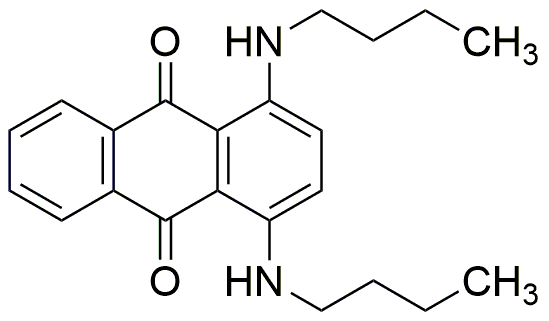Sudan Blue II is widely utilized in research focused on:
- Histology and Pathology: This dye is commonly used to stain lipids in tissue samples, allowing researchers to visualize fat deposits in cells and tissues, which is crucial for diagnosing various diseases.
- Food Industry: Sudan Blue II serves as a colorant in food products, helping to enhance visual appeal. However, its use is regulated due to potential health concerns, making it essential for manufacturers to adhere to safety guidelines.
- Environmental Monitoring: The compound is employed in studies to detect and quantify oil spills and other hydrocarbon pollutants in water bodies, aiding in environmental protection efforts.
- Biochemical Research: It is used as a marker in various biochemical assays, particularly in studying the behavior of lipids and their interactions with proteins, which is vital for understanding metabolic processes.
- Textile Industry: Sudan Blue II is utilized in dyeing processes, providing vibrant colors to fabrics while being mindful of environmental regulations to ensure safe usage.
General Information
Properties
Safety and Regulations
Applications
Sudan Blue II is widely utilized in research focused on:
- Histology and Pathology: This dye is commonly used to stain lipids in tissue samples, allowing researchers to visualize fat deposits in cells and tissues, which is crucial for diagnosing various diseases.
- Food Industry: Sudan Blue II serves as a colorant in food products, helping to enhance visual appeal. However, its use is regulated due to potential health concerns, making it essential for manufacturers to adhere to safety guidelines.
- Environmental Monitoring: The compound is employed in studies to detect and quantify oil spills and other hydrocarbon pollutants in water bodies, aiding in environmental protection efforts.
- Biochemical Research: It is used as a marker in various biochemical assays, particularly in studying the behavior of lipids and their interactions with proteins, which is vital for understanding metabolic processes.
- Textile Industry: Sudan Blue II is utilized in dyeing processes, providing vibrant colors to fabrics while being mindful of environmental regulations to ensure safe usage.
Documents
Safety Data Sheets (SDS)
The SDS provides comprehensive safety information on handling, storage, and disposal of the product.
Product Specification (PS)
The PS provides a comprehensive breakdown of the product’s properties, including chemical composition, physical state, purity, and storage requirements. It also details acceptable quality ranges and the product's intended applications.
Certificates of Analysis (COA)
Search for Certificates of Analysis (COA) by entering the products Lot Number. Lot and Batch Numbers can be found on a product’s label following the words ‘Lot’ or ‘Batch’.
*Catalog Number
*Lot Number
Certificates Of Origin (COO)
This COO confirms the country where the product was manufactured, and also details the materials and components used in it and whether it is derived from natural, synthetic, or other specific sources. This certificate may be required for customs, trade, and regulatory compliance.
*Catalog Number
*Lot Number
Safety Data Sheets (SDS)
The SDS provides comprehensive safety information on handling, storage, and disposal of the product.
DownloadProduct Specification (PS)
The PS provides a comprehensive breakdown of the product’s properties, including chemical composition, physical state, purity, and storage requirements. It also details acceptable quality ranges and the product's intended applications.
DownloadCertificates of Analysis (COA)
Search for Certificates of Analysis (COA) by entering the products Lot Number. Lot and Batch Numbers can be found on a product’s label following the words ‘Lot’ or ‘Batch’.
*Catalog Number
*Lot Number
Certificates Of Origin (COO)
This COO confirms the country where the product was manufactured, and also details the materials and components used in it and whether it is derived from natural, synthetic, or other specific sources. This certificate may be required for customs, trade, and regulatory compliance.


